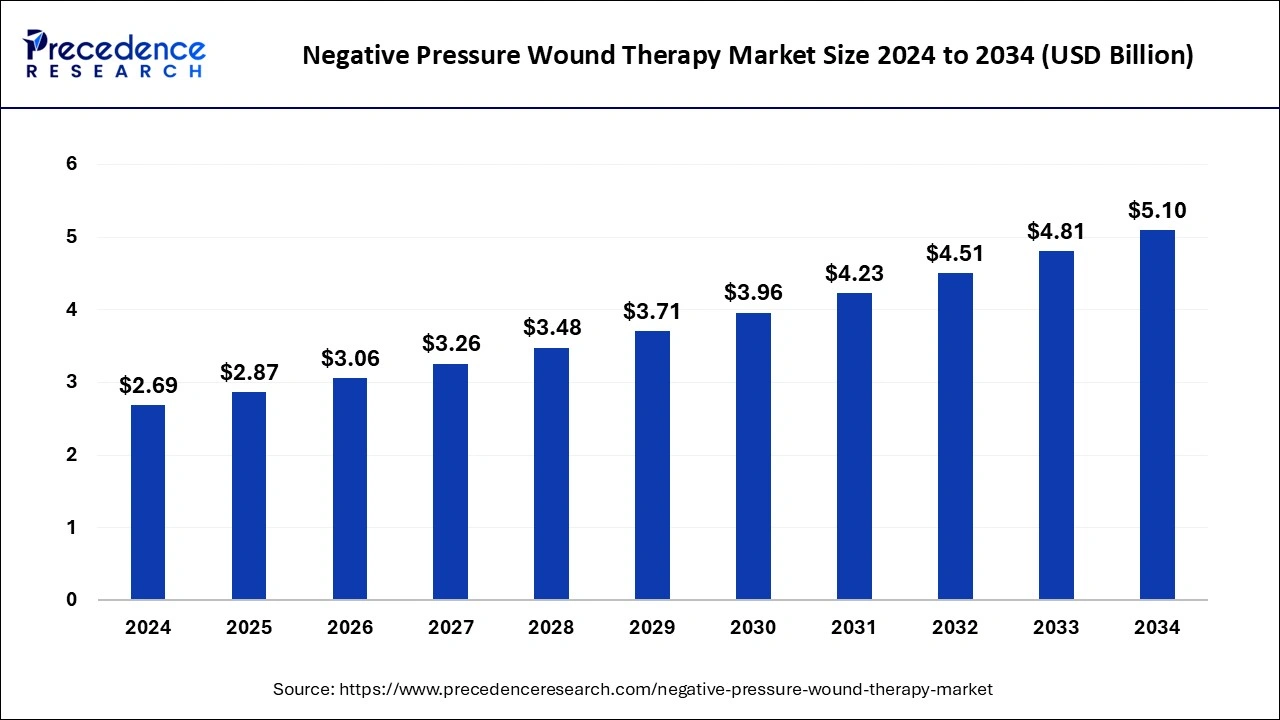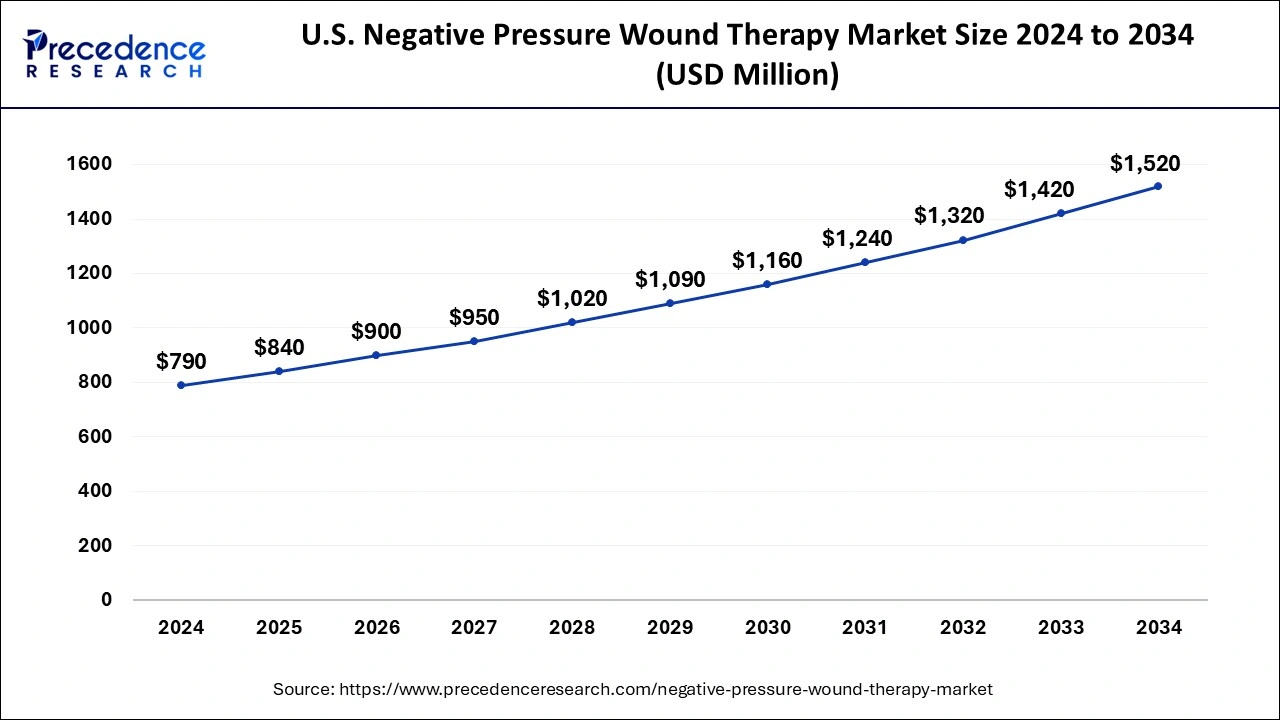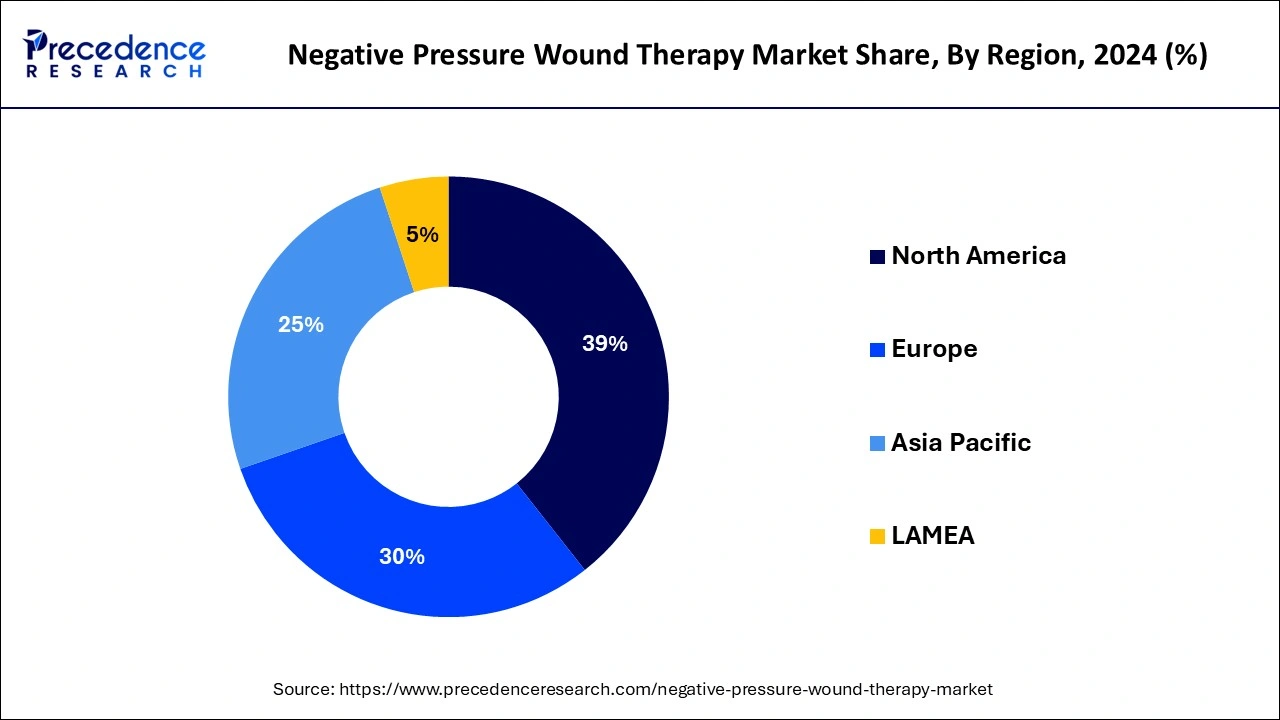Negative Pressure Wound Therapy Market Size and Forecast 2025 to 2034
The global negative pressure wound therapy market size was estimated at USD 2.69 billion in 2024 and is predicted to increase from USD 2.87 billion in 2025 to approximately USD 5.10 billion by 2034, expanding at a CAGR of 6.61% from 2025 to 2034. There are many benefits of using NPWT such as promoting a moist wound healing environment, facilitating the growth of new tissue, improving blood circulation in the wound bed, reducing swelling, etc which contribute to the growth of the market.

Negative Pressure Wound Therapy Market Key Takeaways
- The global negative pressure wound therapy market was valued at USD 2.69 billion in 2024.
- It is projected to reach USD 5.10 billion by 2034.
- The market is expected to grow at a CAGR of 6.61% from 2025 to 2034.
- North America dominated the negative pressure wound therapy market with revenue share of 39% in 2024.
- Asia Pacific is estimated to be the fastest growing during the forecast period of 2025-2034.
- By product type, the conventional NPWT devices segment dominated the market in 2024.
- By product type, the single-use NPWT devices segment is expected to be the fastest growing during the forecast period.
- By wound type, the chronic wounds segment dominated the market in 2024.
- By wound type, the acute wounds segment is expected to be the fastest growing during the forecast period.
- By end-user type, the hospitals segment dominated the market in 2024.
- By end-user type, the home healthcare segment is estimated to be the fastest growing during the forecast period.
U.S.Negative Pressure Wound Therapy Market Size and Growth 2025 to 2034
The U.S. negative pressure wound therapy market size was estimated at USD 790 million in 2024 and is predicted to be worth around USD 1,520 million by 2034, growing at a CAGR of 6.76% from 2025 to 2034.

North America dominated the negative pressure wound therapy market in 2024. Negative pressure wound therapy is widely used in the North American region. The rising senior population and rising hospitals lead to the growth of the market. Negative pressure wound therapy is commonly provided with V.A.C. (Vacuum Assisted Closure) KCI, TX, USA system using a sealed open-spore gauze or spore, which is now commonplace in trauma and orthopedic departments. The majority of U.S. military casualties with wounds appeared in the United States with negative pressure wound therapy (NPWT) devices in place. In the Canadian community healthcare settings, single-use or disposable negative pressure wound therapy devices are used for the treatment. These factors help to the growth of the market in this region.
- In April 2024, RENASYS EDGE, a negative pressure wound therapy (NPWT) system in the United States, was launched by a medical technology company, Smith+Nephew. This system is designed to improve home-based care for patients who suffer from chronic wounds.

Asia Pacific is estimated to be the fastest-growing during the forecast period of 2025-2034. China is the leading country in the demand for advanced wound care technologies. The Chinese herbal medicines put together with negative pressure wound therapy (NPWT) may effectively functionally promote wound healing, shorten disease course in patients, and reduce inflammation. These factors help to grow the negative pressure wound therapy market in this region.
United States
At the moment, the U.S. has the esstential NPWT market globally, benefiting from its tried and tested healthcare system, especially high diabetes rates and high growth rates of clients over the age of 65. Withover 37 million Americans living with diabetes, the morbidity of diabetic foot ulcers and chronic wounds creates demand for advanced wound therapies and NPWT. High reimbursement rates from the Center for Medicare & Medicaid Services, and companies like 3M (Acelity), Cardinal Health, and Smith & Nephew, maintains NPWT growth rates. In addition, there is increasing patient demand for portable and home-care NPWT devices to wound care outside of a professional clinical practice.
Germany
Germany is the largest economy in Europe and its Negative Pressure Wound Therapy market is well established and technologically advanced with it having an increasingly older population and with Hospital resources dedicated to its clinical efficacy and patient outcomes. The German government has policies and reimbursement practices that promote NPWT use in Hospitals and outpatient care procedures via its publicly funded Statutory Health Insurance (SHI) system, thereby making NPWT a common treatment practice. German clinicians are evidence-based and continually evaluate the best use of advanced therapies within their practice.
Japan
The NPWT market in Japan continues to grow steadily, spurred on by its super-aged society—over 29% of the population is 65 years of age or older—and the increasing incidents of chronic wounds, pressure ulcers, and surgical site infections. The Japanese healthcare system is known for its universal coverage and high standards, and it encourages advanced wound care technology as part of the current healthcare standard. The market was further accelerated by the increasing acceptance of NPWT as part of clinical practice by both healthcare professionals and patients. In addition, the significant uptake in investments toward R&D and medical robotics offer new opportunities for NPWT innovation within Japan.
Market Overview
The negative pressure wound therapy market includes a segment of the advanced wound care industry focused on the production, distribution, and sales of negative pressure wound therapy (NPWT) devices. Negative pressure wound therapy (NPWT) is used to improve the physiology of wound healing by the application of sub-atmospheric pressure to promote granulation tissue and reduce inflammatory exudate. It is used to treat difficult wounds that are at risk of non-healing, like skin grafts or diabetic foot ulcers. The benefits of negative pressure wound therapy (NPWT) include minimization of inflammation, easy growth of new tissue, and support for wound closure. It helps to improve blood circulation, reduces swelling, stimulates antibacterial actions by preventing infections, drains excess fluid from the wound bed, improves quality of life, nursing costs savings, less necessity of surgeries, less wound dressing changes, and earlier hospital discharge.
Negative Pressure Wound Therapy Market Growth Factors
- Use of negative pressure wound therapy helps to reduce or minimize inflammation, redness, or swelling and to decrease the number of bacteria.
- It helps to promote a moist wound-healing environment, improve the growth of new tissue, support wound closure, improve blood circulation, stimulate antibacterial action, and prevent infections, which contributes to the growth of the negative pressure wound therapy market.
- It helps to improve quality of life, saves nursing costs, fewer necessities of surgeries, fewer wound dressing changes, and earlier hospital discharge, which helps the growth of the market.
- It is used as a supplement to flap or skin graft procedures, dehisced and subacute incisions, open and chronic wounds, pressure ulcers, acute surgical and traumatic wounds, and meshed grafts, these factors help to the growth of the market.
Key factors influencing future market trends
- Development of User-Friendly and Portable Solutions: More clients are looking for NPWT devices that can be used at home and are easy to manage. They allow patients to be treated in other locations and not solely in hospitals. Having a portable NPWT system supports patients and their caregivers, since wound management can occur at home or in an outpatient clinic.
- Increasing Investment in Healthcare: An increase in investments in healthcare and wound care technologies in emerging countries is boosting the growth of NPWT. Both the government and private sectors are promoting new and advanced approaches in caring for wounds. As a result, more clinics can use modern wound care equipment and treatment.
- Outpatient Care for Management of the Illness: More patients are now attending appointments outside of the hospital and at their homes. As a result, more people are looking for NPWT devices that can be utilized safely and correctly around the home. Shorter hospitalization, less cost for healthcare, and greater comfort for patients during wound recovery are all benefits of ambulatory NPWT.
Market Scope
| Report Coverage | Details |
| Growth Rate from 2025 to 2034 | CAGR of 6.61% |
| Market Size in 2025 | USD 2.87 Billion |
| Market Size by 2034 | USD 5.10 Billion |
| Largest Market | North America |
| Base Year | 2024 |
| Forecast Period | 2025 to 2034 |
| Segments Covered | Product Type, Wound Type, End-use Type, and Region |
| Regions Covered | North America, Europe, Asia-Pacific, Latin America, and Middle East & Africa |
Market Dynamics
Drivers
Rising senior population
In the senior population, there is a prevalence of pressure ulcers, also known as pressure sores, bedsores, and decubitus ulcers. These are localized injuries to the underlying structures or the skin that need negative pressure wound therapy for treatment. In the senior population, incidents and prevalence rates are high because of multifactorial risk factors like physiological changes, medications affecting the skin, nutritional habits, changes in functional status, and comorbidities. As the senior population increases, the prevalence of chronic diseases also increases. Senior individuals are more open to chronic diseases, including heart disease, cancers, and diabetes. These factors help to the growth of the negative pressure wound therapy market.
Restraint
Contraindications and complications of the negative pressure wound therapy (NPWT)
Negative pressure wound therapy may be unsuitable for some wounds, including wounds because of skin cancer, inflamed bones (Osteomyelitis), eschar, dead or necrotic tissue that has not been cleaned, and tunnels or fistulas to body cavities and organs. The disadvantages of negative pressure wound therapy include initial pain because of the application of a negative pressure wound therapy device, and it is necessary to connect to the unit for a day at least 22 hours. The non-healing wound can require potentially more intrusive treatment than negative pressure wound therapy, and the therapy is not always effective. These complications may restrict the growth of the negative pressure wound therapy market.
Opportunities
Advanced technologies
Improvement in the negative pressure wound therapy for wound healing encouragements in orthopedic and traumatic wounds. Use of NPWTi-d (Negative pressure wound therapy instillation and dwell time for the management of orthopedics and traumatic wounds that provides unique challenges. Development of its applications and cost-effective analysis are guidelines based on randomized and longitudinal controlled research trials. These factors help to the growth of the negative pressure wound therapy market.
Use of disposable and portable models
The use of disposable and portable models for negative pressure wound therapy has many benefits, including minimizing risks of infections and eliminating the necessity of sterilizations, maintenance, and cleaning. Lack of manpower and time for healthcare sectors to reprocess medical products, which is helpful for healthcare professionals to use disposable and portable models. Disposable devices save healthcare professionals time and effort. Portable models help patients to take treatments at home. These factors are helpful for the growth of the negative pressure wound therapy market.
Product Type Insights
The conventional NPWT devices segment dominated the market in 2024. In conventional NPWT-type devices, foam dressing is placed above the wound, which is sealed with impervious and an adhesive film and is connected to a vacuum pump, which creates negative pressure and removes air from the dressing. Conventional NPWT devices are ideal for deep, large wounds or heavily exudating wounds as they may manage fluid which is in large amounts. The adoption of conventional NPWT devices is increasing globally. It is useful for reducing costs and helps with earlier hospital discharges. These factors help to the growth of the segment and contribute to the growth of the negative pressure wound therapy market.
The single-use NPWT devices segment is expected to grow the fastest during the forecast period. The single-use NPWT devices are disposable, lightweight, and smaller. This device provides an effective and safe alternative to conventional negative pressure wound therapy. It helps to reduce complication rates of closed surgical incisions and provides healing of select open wounds. These devices are designed for home care use, and they can be used for primary treatment options. These factors help to the growth of the segment and contribute to the growth of the negative pressure wound therapy market.
Wound Type Insights
The chronic wounds segment dominated the market in 2024. In the chronic wound type, negative pressure wound therapy is used. This inflamed wound or chronic wound type is regularly cleaned by healthcare professionals who remove infected or dead tissue also and the treatment is known as debridement. Chronic wounds include infected cuts, large burns, deep ulcers, pressure ulcers, diabetic ulcers, arterial ulcers, and venous ulcers. For these certain wounds negative pressure wound therapy is recommended. These factors help to the growth of the segment and contribute to the growth of the negative pressure wound therapy market.
The acute wounds segment is estimated to be the fastest growing during the forecast period. When acute wounds are not covered or closed by primary intention because of swelling or skin tension, active infections, and risk of infections, negative pressure wound therapy is recommended for treatment. Acute wounds include traumatic burns or injuries and surgical incisions. The use of negative pressure wound therapy for acute wounds has grown increasingly popular. These factors help to the growth of the segment and contribute to the growth of the negative pressure wound therapy market.
End-use Type Insights
The hospitals segment dominated the negative pressure wound therapy market in 2024. Negative pressure wound therapy is used for the treatment of complex wounds and is now commonplace in outpatient and various clinical settings and hospitals. The use of negative pressure wound therapy in hospitals is because of the duration of the treatments, size of the wounds, number of debridements, and length of hospital stays. In hospitals for acute wound and chronic wound treatment purposes, negative pressure wound therapy is used. These chronic wound and acute wound types are the key factors for the use of this therapy in hospitals. An increasing number of hospitals leads to growth in the market. These factors help the growth of the segment and contribute to the growth of the market.
The home healthcare end-use type segment is expected to grow the fastest during the forecast period. Negative pressure wound therapy is a portable device that is used for patients to heal at home. Mostly for patients who suffer from chronic disease, there is a high use of home-based healthcare negative pressure wound therapy. In diabetic wound salvage and peripheral artery disease, there is the use of home-based negative pressure wound therapy. It is also helpful for the chronic and acute diseases. This home-based negative pressure wound therapy minimizes the risks of hospitalization. These factors help to the growth of the segment and contribute to the growth of the negative pressure wound therapy market.
Negative Pressure Wound Therapy Market Companies
- Acelity
- Conva Tec Inc.
- Cardinal Health
- Cork Medical
- DeRoyal Industries, Inc.
- Genadyne Biotechnologies Inc
- Invacare Corporation
- 3M
- Molnlycke Health Care
- Paul Hartmann AG
- Smith+Nephew
- Sanoma Pharmaceuticals
- Tally Group Ltd
Recent Developments
- In March 2024, Smith & Nephew issued an urgent recall of the RENASYS EDGE canister, which had a carbon-filter issue capable of contaminating pumps—showcased by a Class II FDA recall notice dated March 11, 2024.
(Source- https://www.accessdata.fda.gov) - On April 18, 2024, DeRoyal Industries secured FDA clearance, for the Prospera Spectruum™ NPWT System (K230233), approved for use in acute, extended, and home-care settings.
(Source- https://www.accessdata.fda.gov) - In April 2024, Smith+Nephew, a global medical technology company, announced its launch in the U.S. of the RENASYS EDGE Negative Pressure Wound Therapy (NPWT) System as a patient-centric solution for the management of chronic wounds. The system is lightweight and compact, so it is easy to transport or wear.
- In August 2023, Medela announced plans for expanding its negative pressure wound therapy (NPWT) portfolio with the launch of the new Invia Integrated Dressing. The new sterile dressing is indicated for all wound types, including closed surgical incisions. The dressing can be used at home or hospital for up to seven consecutive days.
- In April 2023, Convatec Group PLC announced the acquisition of 30 Technology Limited's anti-infective nitric oxide technical platform. The acquisition includes new product assets and R&D.
- In August 2022, a new software upgrade for the 3M V. A. C. Ulta Therapy Unit and 3M Veraflo Cleanse Choice Complete Dressing Kit was introduced by 3M Healthcare Solutions Division and made negative pressure wound therapy with instillation easier for clinicians to initiate.
- In August 2023, a new Invia Integrated Dressing for wounds indicating all types of wounds, like closed surgical incisions, was launched by Medela to expand its negative pressure wound therapy (NPWT) system.
Segments Covered in the Report
By Product Type
- Conventional NPWT Devices
- Single-use NPWT Devices
- NPWT Accessories
By Wound Type
- Chronic Wounds
- Pressure Ulcer
- Diabetic Foot Ulcer
- Venous Leg Ulcer
- Others
- Acute Wounds
- Surgical & Traumatic Wounds
- Burns
By End-use Type
- Hospital
- Specialty Clinics
- Home Healthcare
- Others
By Geography
- North America
- Asia Pacific
- Europe
- Latin America
- Middle East & Africa
For inquiries regarding discounts, bulk purchases, or customization requests, please contact us at sales@precedenceresearch.com
Frequently Asked Questions
Ask For Sample
No cookie-cutter, only authentic analysis – take the 1st step to become a Precedence Research client
 sales@precedenceresearch.com
sales@precedenceresearch.com
 +1 804-441-9344
+1 804-441-9344